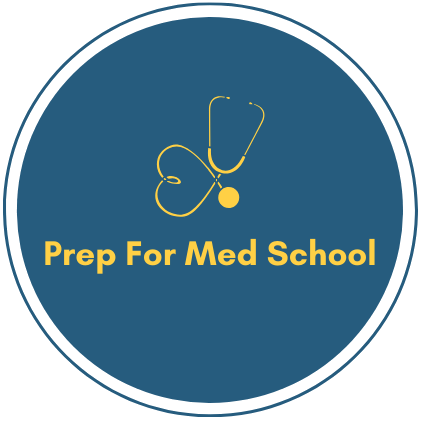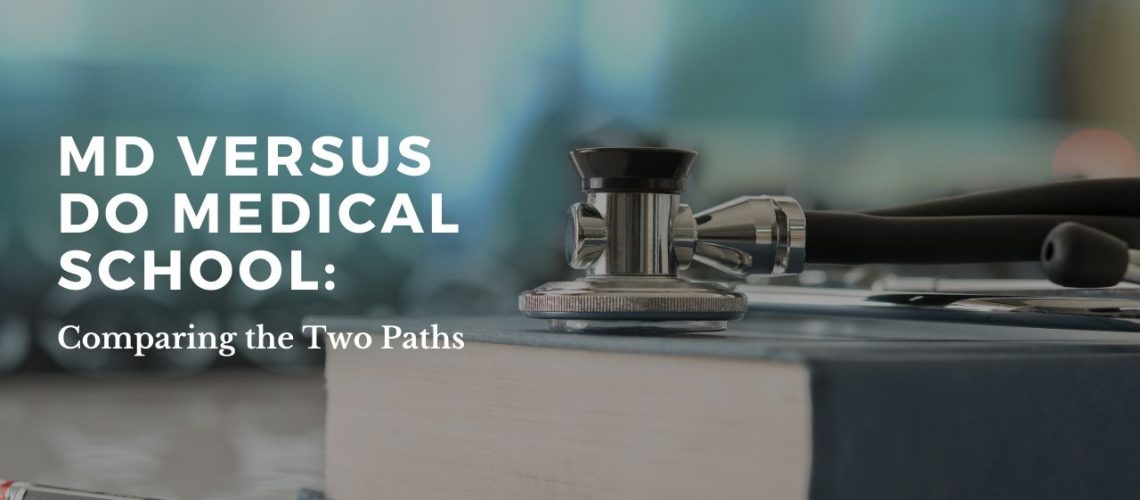There are two main paths to becoming a fully-fledged practicing physician in the United States: allopathic programs and osteopathic programs. Given the similarities between these two programs, it can be confusing to differentiate the two, especially when it comes time to decide which program(s) to apply to.
In this article, we will delve into the differences between these two programs in terms of admissions, curriculum, and career outcomes.
MD Schooling Versus DO Schooling
Allopathic and osteopathic medical schools are very similar in most aspects. Students in both programs are required to take preclinical coursework. These cover concepts such as anatomy, physiology, microbiology, immunology, neuroscience, and pathophysiology. This often lasts two years in both programs. The last two years are also quite similar; students will participate in clinical rotations and then apply to match for residency during their fourth year.
However, osteopathic programs have an additional component known as osteopathic manipulative treatment (OMT) that provides additional training on the musculoskeletal system. Students are trained to perform hands-on techniques that allow them to analyze and provide benefits to paints suffering from certain conditions.
Osteopathic practitioners believe that OMT can benefit a diverse set of conditions by providing pain relief and increased mobility. By applying specific amounts of pressure to regions of the body, they can help promote blood flow, address structural abnormalities, and adjust misaligned joints. According to the American Osteopathic Association, OMT may provide relief with conditions such as asthma, migraines, and carpal tunnel syndrome.
Osteopathy also emphasizes a holistic approach that teaches how structure and function in the body are connected. This perspective, in addition to OMT, is applied to patients when appropriate alongside traditional interventions.
Applying for MD Schools Versus DO Schools
The application process for allopathic MD schools and osteopathic DO schools is quite similar, although there are a few differences. Both programs require that pre-med students complete a bachelor’s degree with the necessary coursework and take the MCAT. Shadowing, research, and extracurriculars are very important for both programs.
The centralized online application service is different for these programs. In order to apply for MD schools, students must utilize the American Medical College Application Service (AMCAS). DO applicants use the American Association of Colleges of Osteopathic Medicine Application Service (AACOMAS).
DO school applicants are required to have shadowed an osteopathic physician and demonstrate knowledge of osteopathic medicine. An applicant should emphasize a strong desire to learn osteopathic medicine and make it clear that they are not pursuing it as a backup to allopathic medicine.
Some students simultaneously apply for both DO and MD schools. Although it may be challenging to balance both application processes, it allows students to expand their options and increase their chances of being admitted into at least one medical school.
Admission Standards of Allopathic Versus Osteopathic Schools
On average, the admissions standard for DO schools is lower than their MD counterparts.
According to the 2018 AACOMAS Applicant and Matriculant Profile, 20,981 students applied for DO school and 7,415 (35.3%) matriculated into an osteopathic program. Matriculants had an average undergraduate science GPA of 3.43 and an average total undergraduate GPA of 3.54. The average MCAT score for matriculants was 503.
In 2018, 52,777 students applied to MD schools and 21,622 (40.9 %) matriculated into a U.S. allopathic program. Matriculants had an average undergraduate science GPA of 3.65 and an average total undergraduate GPA of 3.72. The average MCAT for MD matriculants was 511.5.
Board Exams
There are slight differences in the board exams that DO and MD students take. MD students must take the United States Medical Licensing Examinations (USMLE), a three-step examination, over the course of their medical training.
In contrast, DO students are required to take the Comprehensive Osteopathic Medical Licensing Examination (COMLEX) in order to apply to American Osteopathic Association residencies (which will be referred to as “DO” residencies from this point forward). However, DO students have the option to take the USMLE exams if they wish to apply to MD residencies.
Although there are some significant changes with the announcement of the Accreditation Council for Graduate Medical Education (ACGME) merger, the testing requirements remain the same. The COMLEX will still be required to license osteopathic physicians and will be heavily emphasized in the evaluation of DO students who apply to DO residencies. However, MD applicants will be able to apply to DO residencies without taking the COMPLEX.
Residency and Fellowship
The topic of residencies for DO and MD schools is an evolving subject. Historically, the two were distinct. DO residencies were only open to DO applicants and required students to have taken the COMLEX. However, MD residencies were open to both DO and MD applicants, provided that the applicants had taken the USMLE.
These DO residencies were offered in a number of specialties such as internal medicine, emergency medicine, anesthesiology, dermatology, and neurosurgery. However, there were fewer DO residency programs compared to MD programs.
MD residency programs are much more numerous and tend to be more diverse, in terms of both specialties offered and geographical location. However, DOs have often had less success matching to these residencies compared to their MD counterparts, especially in competitive specialties.
In 2020, DO and MD residencies will be merged, resulting in several significant changes to residency options for DO and MD students. Previously, DO residencies were exclusive for DO students, but this will no longer be the case as both MD and DO students will be eligible for these positions.
Following the merger, all residents will be considered to be ACGME-trained, removing the stigma that osteopaths may have previously faced as residents in non-ACGME programs. Applicants from DO and MD schools will be considered on the same playing field. Furthermore, graduating from ACGME-accredited residency programs also has the potential to open up fellowship and other opportunities for DOs that may not have been available before.
One potential disadvantage however is that DO residencies will consider both MD and DO applicants. Historically, some DO residencies in competitive specialties such as dermatology and neurosurgery offered DOs some security. Prior to the merger, DOs were able to apply to these residencies without competition from MD applicants. However, this is no longer the case, meaning that it may be harder for DOs to match into more competitive specialties due to this increased competition.
Career Paths of Osteopaths and Allopaths
Historically, DOs were more likely to be primary care specialists in specialties such as general medicine, family medicine, internal medicine, or pediatrics. This may be due to a variety of factors, such as the emphasis that many osteopathic schools have on primary care.
However, another factor to consider is that osteopathic practitioners who are strong believers in the osteopathic philosophy. Those that wish to continue their practice of OMT will find that primary care clinics are the best way for them to apply their OMT skills. This may bias some of these students towards primary care specialties.
DOs have always been able to specialize in specialties, including but not limited to urology, psychiatry, orthopedic surgery, ophthalmology, and neurosurgery. DOs were able to specialize in these fields either through DO-only residency programs or by training alongside MD colleagues in ACGME-accredited residency programs.
The key point here is that although most DOs have gravitated towards primary care specialties for one reason or another, they are not limited in their choice of specialty.
Historically, MDs have had an advantage over DOs in being competitive for these specialty programs. One concern for osteopaths is that with the merger, it may be even more difficult for them to secure a residency position in a competitive specialty.
According to the 2018 Match statistics, 94.3% of US allopathic students matched to first-year residency positions while 81.7% of DOs did the same. The percentage of DOs and MDs who matched into their specialty of choice is listed below:
| Specialty | MD | DO |
| Anesthesiology | 96.0% | 90.2% |
| Child Neurology | 99.0% | 90.9% |
| Dermatology | 81.6% | 36.7% |
| Diagnostic radiology | 88.9% | 81.0% |
| Emergency Medicine | 91.4% | 81.9% |
| Family medicine | 95.3% | 90.6% |
| General Surgery | 84.0% | 50.0% |
| Internal Medicine | 97.9% | 92.8% |
| Internal medicine/pediatrics | 93.5% | 85.% |
| Interventional Radiology | 58.3% | 15.0% |
| Neurosurgery | 86.4% | 30.0% |
| Neurology | 95.7% | 90.7% |
| OB/GYN | 87.9% | 61.3% |
| Orthopedic surgery | 82.4% | 23.4% |
| Pathology | 96.4% | 93.0% |
| Pediatrics | 98.8% | 88.7% |
| Physical medicine and rehabilitation | 87.9% | 66.9% |
| Psychiatry | 84.0% | 72.5% |
Concluding remarks
In the end, DO and MD programs both allow students to achieve their goals of becoming physicians. MD programs are more difficult to matriculate into on average, however, they have higher match success rates, especially when it comes to more competitive specialties.
At the end of the day, it is up to the student to put in the effort and succeed academically to reach their goals. DO students have succeeded and outcompeted MD students in the past as evidenced by their ability to secure competitive residency positions. They can still reach the same endpoint as MD students, although they may have to navigate a more challenging road to get there.
- https://medschool.ucla.edu/body.cfm?id=1158&action=detail&ref=1019
- https://jaoa.org/article.aspx?articleid=2093249
- https://www.aacom.org/become-a-doctor/how-to-apply-to-osteopathic-medical-college
- https://choosedo.org/admission-requirements/
- https://www.aacom.org/docs/default-source/data-and-trends/2018-aacomas-applicant-matriculant-profile-summary-report.pdf?sfvrsn=28753a97_14
- https://www.aamc.org/system/files/2019-11/2019_FACTS_Table_1_0.pdf
- https://www.aamc.org/system/files/2019-10/2019_FACTS_Table_A-16.pdf
- https://blog.matcharesident.com/5-ws-of-the-acgme-merger-mddo-merger/
- http://opportunities.osteopathic.org/search/search.cfm
- http://www.nrmp.org/wp-content/uploads/2018/06/Charting-Outcomes-in-the-Match-2018-Osteo.pdf
- https://mk0nrmp3oyqui6wqfm.kinstacdn.com/wp-content/uploads/2019/10/Charting-Outcomes-in-the-Match-2018_Seniors-1.pdf







